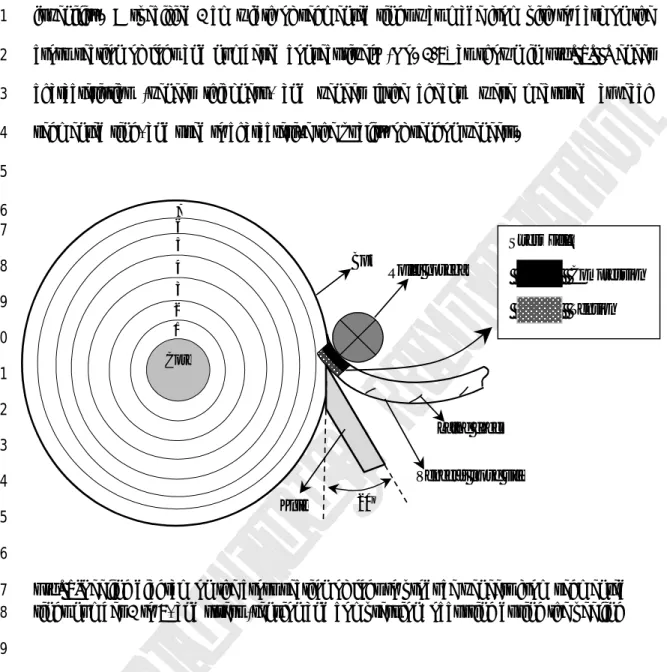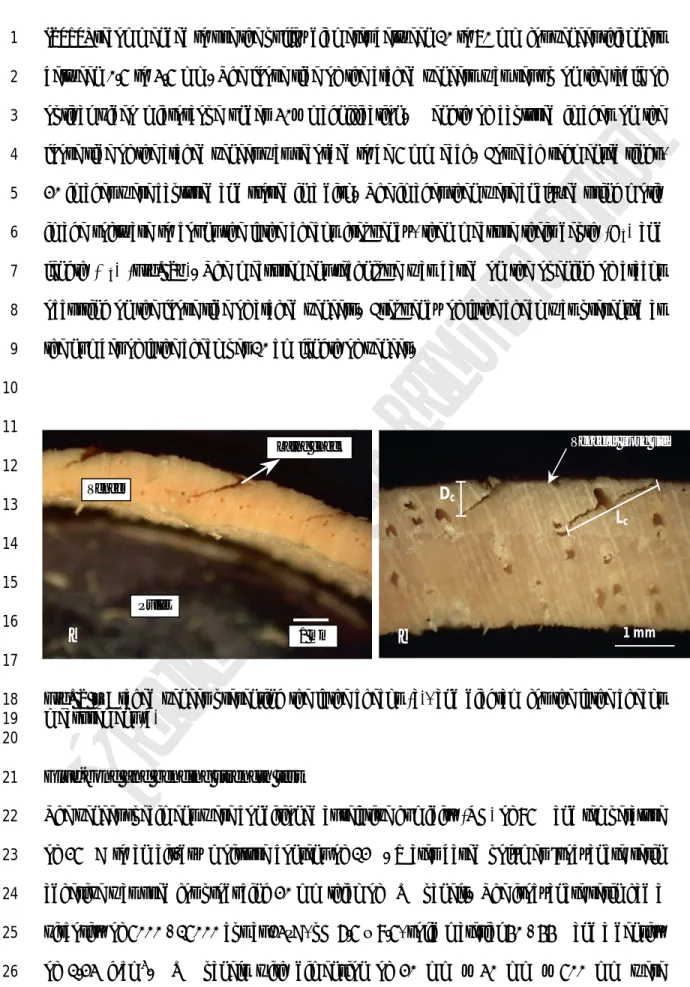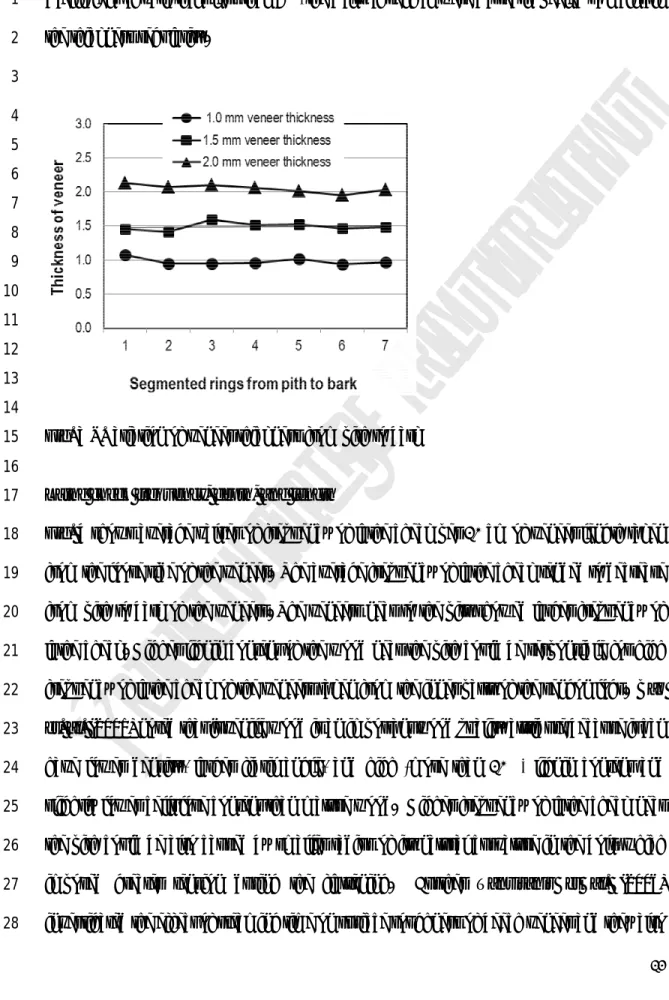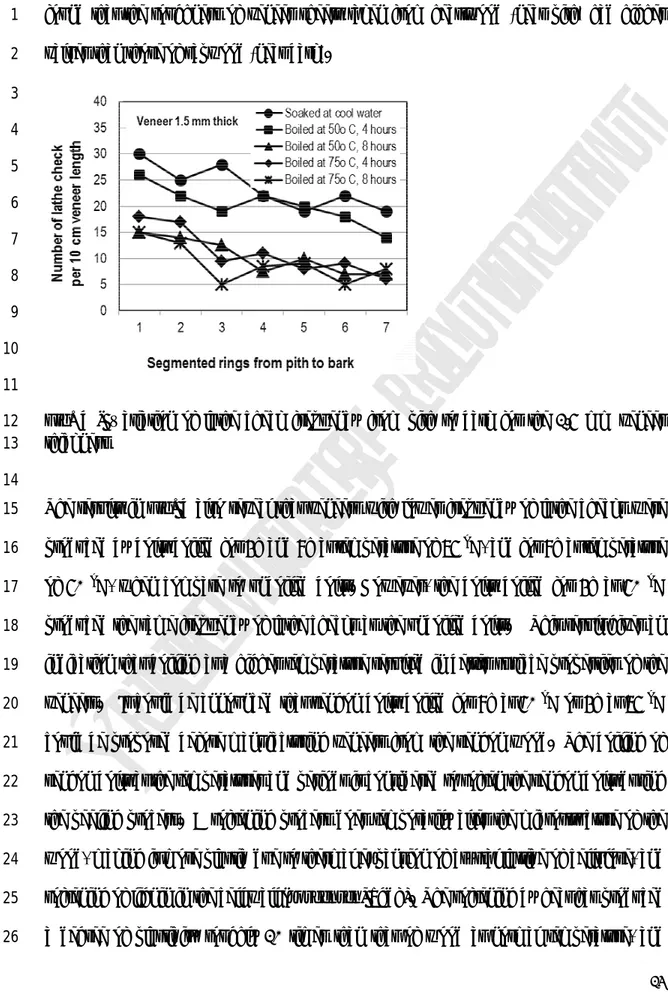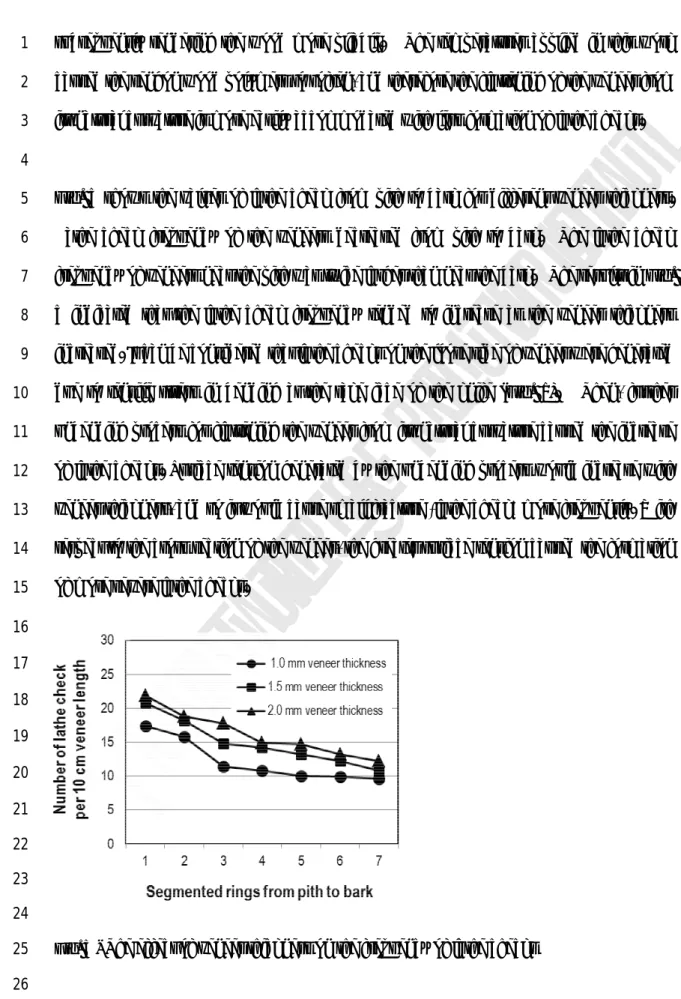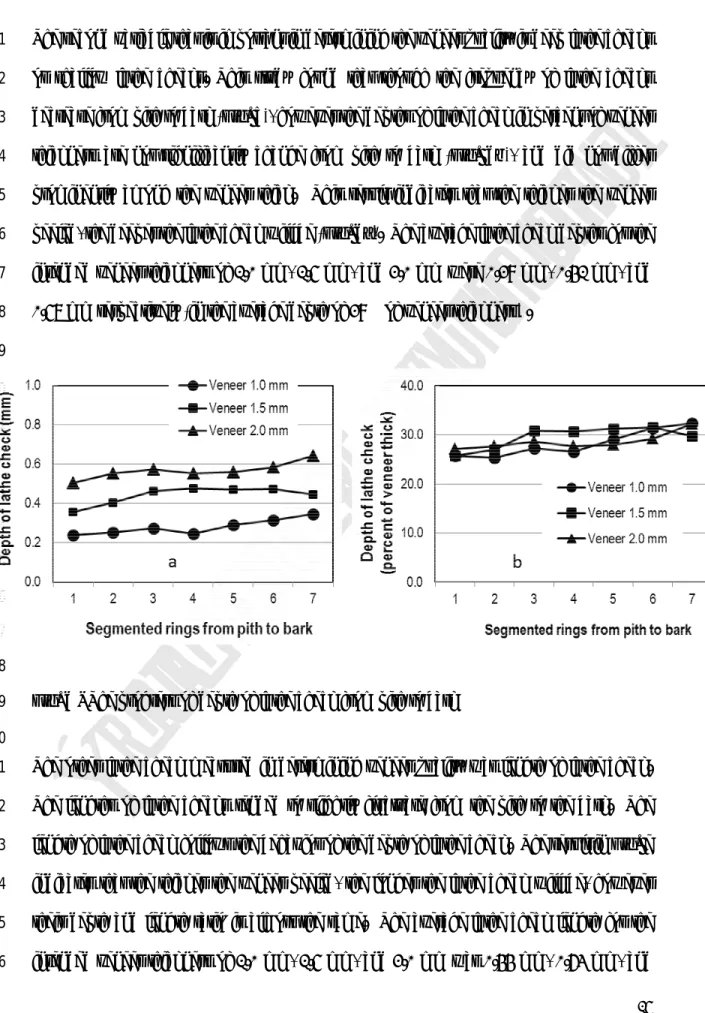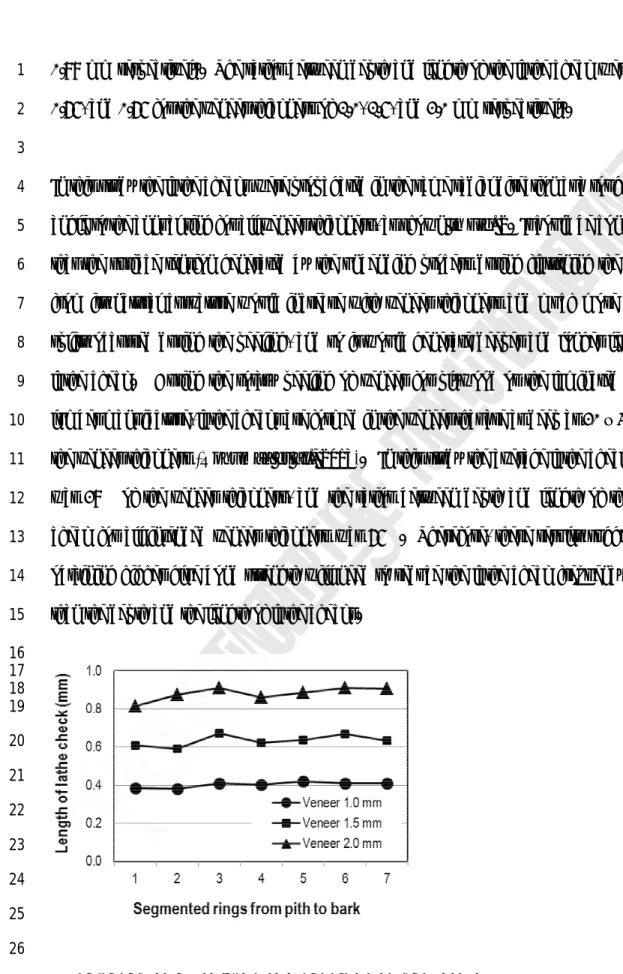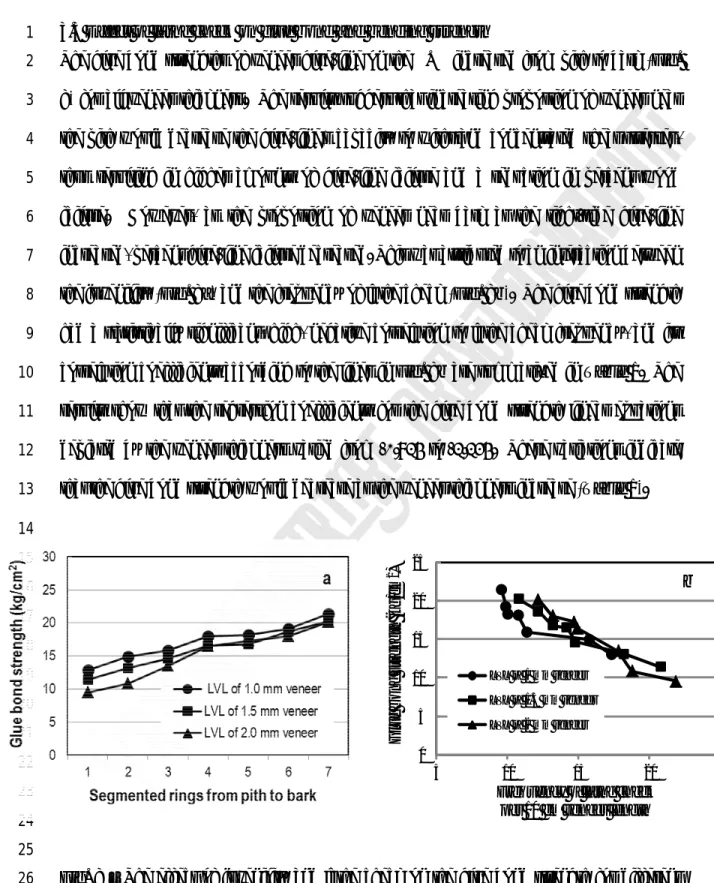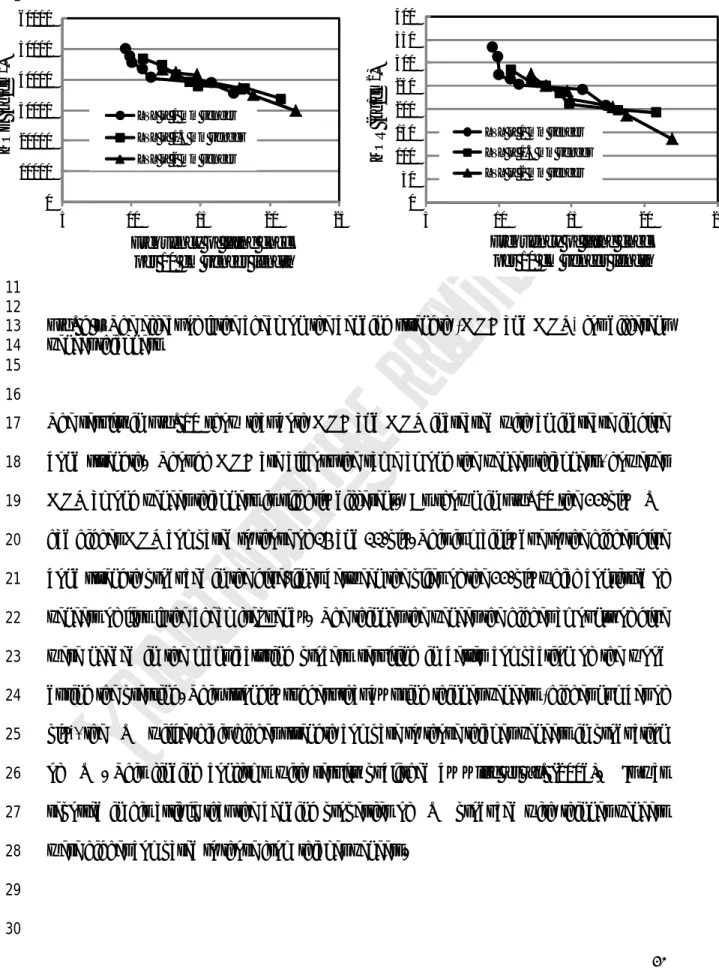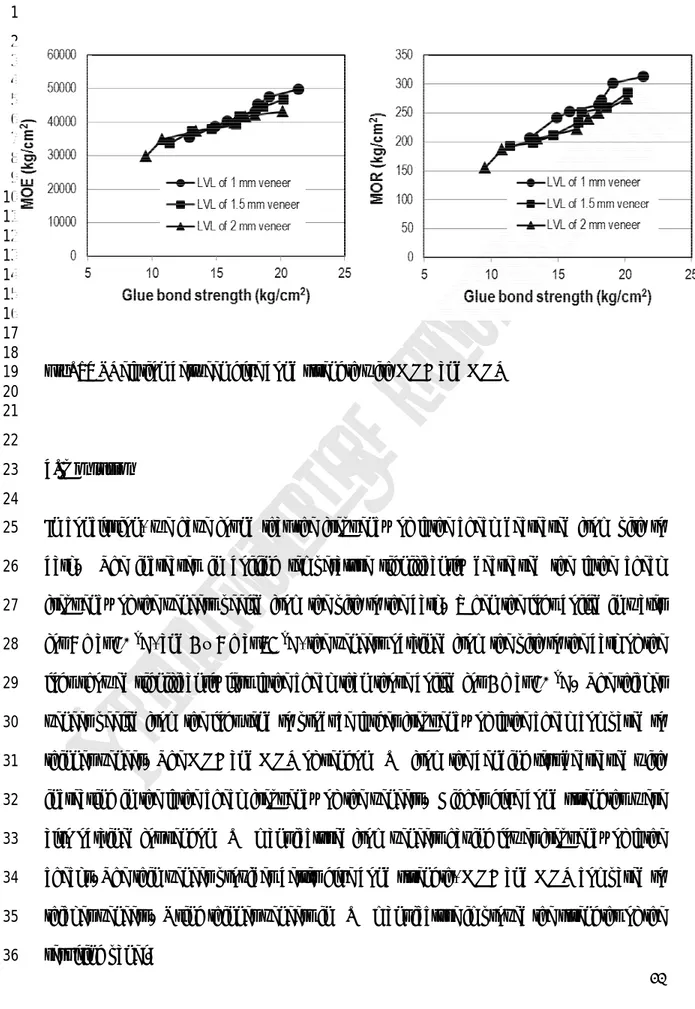Science Arts & Métiers (SAM)
is an open access repository that collects the work of Arts et Métiers Institute of Technology researchers and makes it freely available over the web where possible.
This is an author-deposited version published in: https://sam.ensam.eu Handle ID: .http://hdl.handle.net/10985/8485
To cite this version :
Yusram MASSIJAYA, Abigael KABE, Istie RAHAYU, Louis DENAUD, Barbara OZARSKA - Lathe Check Characteristics of Fast Growing Sengon Veneers and Their Effect on LVL Glue-Bond and Bending Strength - Journal of Materials Processing Technology p.8 - 2014
Accepted Manuscript
Title: Lathe Check Characteristics of Fast Growing Sengon Veneers and Their Effect on LVL Glue-Bond and Bending Strength
Author: Wayan Darmawan Dodi Nandika Yusram Massijaya Abigael Kabe Istie Rahayu Louis Denaud Barbara Ozarska
PII: S0924-0136(14)00315-X
DOI: http://dx.doi.org/doi:10.1016/j.jmatprotec.2014.08.015
Reference: PROTEC 14095
To appear in: Journal of Materials Processing Technology Received date: 11-2-2014
Revised date: 6-6-2014 Accepted date: 16-8-2014
Please cite this article as: Darmawan, W., Nandika, D., Massijaya, Y., Kabe, A., Rahayu, I., Denaud, L., Ozarska, B.,Lathe Check Characteristics of Fast Growing Sengon Veneers and Their Effect on LVL Glue-Bond and Bending Strength, Journal of Materials Processing Technology (2014), http://dx.doi.org/10.1016/j.jmatprotec.2014.08.015 This is a PDF file of an unedited manuscript that has been accepted for publication. As a service to our customers we are providing this early version of the manuscript. The manuscript will undergo copyediting, typesetting, and review of the resulting proof before it is published in its final form. Please note that during the production process errors may be discovered which could affect the content, and all legal disclaimers that apply to the journal pertain.
Accepted Manuscript
1
Original Article 1
This article was written based on the experimental results conducted at Bogor Agricultural Univ., and INRA,
2
Nancy, France
3
This article has not been published elsewhere, and would like to be published at the Journal of Materials
4
Processing Technology
5 6
Lathe Check Characteristics of Fast Growing Sengon Veneers and
7Their Effect on LVL Glue-Bond and Bending Strength
8Wayan Darmawan(1)*, Dodi Nandika(1), Yusram Massijaya(1),
9
Abigael Kabe(2), Istie Rahayu(2), Louis Denaud(3), Barbara Ozarska(4)
10 11
(1)
Prof., Department of Forest Products, Faculty of Forestry, 12
Bogor Agricultural University (IPB),Bogor (16680), Indonesia. 13 Phone +62-251-8621285, Fax. +62-251-8621256 14 E-mail : wayandar@indo.net.id 15 * (Corresponding author) 16 (2)
Research Assistant, Department of Forest Products, Faculty of Forestry, 17
Bogor Agricultural University (IPB), Bogor (16680), Indonesia. 18
(3)
Associate Professor, Art et Metier ParisTech, France 19
(4)
Associate Professor, University of Melbourne, Australia 20
Abstract
21Fast growing sengon (Paraserianthes moluccana) is largely rotary-cut to produce veneer
22
for core plywood production. In order to provide better information on veneer production
23
and utilization, in this study the effects of wood juvenility and veneer thickness on lathe
24
checks of rotary-cut sengon veneers were evaluated. Before veneer manufacturing, sengon
25
logs were boiled at 50 oC and 75 oC for 4 and 8 hours respectively. The boiled logs were
26
peeled to produce veneer of 1 mm, 1.5 mm, 2 mm in thickness. Lathe checks of veneers
27
were measured on the loosed side at every 5 mm veneer length under an optical video
28
microscope and their frequency, depth, and length were characterized. Twenty sampling
29
points of 5 mm veneer length were prepared from each segmented ring of 1 cm width from
30
pith to bark. Isocyanate resin adhesive were used to produce laminated veneer lumber
31
(LVL) of 20 mm thick, which consisted of 24-ply of 1 mm veneer thick, 14-ply of 1.5 mm
32
veneer thick, and 11-ply of 2 mm veneer thick, for glue bond and bending strength test.
33
Results showed that wood juvenility and veneer thickness determined the frequency, depth
34
and length of lathe checks for the sengon rotary-cut veneers. In general, the frequency of
35
lathe checks of the veneer increases with increasing veneer thickness, and also increases
36
from pith to bark. Boiling of logs before rotary-cutting could decreases the frequency of
37
lathe check of the veneer. The results indicated that boiling of logs at 50oC for 8 h and at
38
75 oC at least 4 h before peeling the logs could minimize the frequency of lathe check in
39
manufacturing rotary cut veneer thickness of 1 mm, 1.5 mm, and 2 mm from juvenile
40
wood of fast growing sengon. The frequency of lathe check affect significantly the glue
41
bond and bending strength, in which the glue bond, Modulus of Elasticity (MOE), and
42
Modulus of Rupture (MOR) decrease as the frequency of lathe checks increases.
43
Keyword : Lathe check, Rotary-Cut Veneer, Fast Growing Sengon, Boiling, Glue-bond,
44
Bending Strength, Laminated veneer lumber
45 46
Accepted Manuscript
1. Introduction1
Sengon (Paraserianthes moluccana) is a fast growing wood species widely planted by
2
community in Indonesia. The sengon tress in the age of 7 years can reach breast height
3
diameter up to 38 cm. Though all part of the tress in the age of 7 years are juvenile
4
(Darmawan et al., 2013), however they have been felled in that age because demand of
5
the sengon woods for wood industry is high, and are important incomes for the
6
communities (Krisnawati et al., 2011). Sengon is the most common species used for
7
packaging and pulp in Indonesia. Recently the sengon wood has been rotary cut for
8
laminated-wood products. Since the sengon wood is being used in the laminated wood
9
industry, high bonding properties are expected. However, as the sengon logs are being
10
peeled and much more juvenile woods are being utilized, severe lathe check veneer would
11
undoubtedly be produced and manufactured. Therefore, it considerably needs to study
12
lathe checks of veneer peeled from the sengon logs, and their effect on the glue bond and
13
bending strength.
14 15
The bonding strength of the veneers depends upon a variety of factors. These factors are
16
classified as veneers quality (moisture content, density, lathe checks, and surface
17
roughness) and as adhesive quality (type of adhesive, mixture of adhesive, and its
18
viscosity) and as bonding quality (glue spread, pressure time and temperature, relative
19
humidity, and temperature of air) (Dundar et al., 2008a). Among these factors, lathe
20
check is one of the important factors on the bonding strength. The bonding strength
21
decreases, probably because of the presence of important lathe checks. Also, the veneers
22
with lathe checks require much more glue spread because of the degradation of veneer
23
surface topography (Daoui et al., 2011). Veneers with lathe checks can also cause
24
excessive resin use and may result in resin-bleed through the inside of veneer.
Accepted Manuscript
3 In rotary-cut veneer manufacturing, when peeling starts, the wood tends to split along the
1
grain. Lathe checks are formed at the veneer's loose side (Fig. 1) as tension force of the
2
lathe's knife pulls the veneer away from the peeler block and flattens the veneer from its
3
natural curvature (DeVallance et al., 2007). With respect to the cross section of the
4
veneer, this advance splitting causes the formation of vertical cracks (known as lathe
5
checks). The depth, length and frequency of lathe checks have been widely taken into
6
account during veneer surface quality evaluation. The risk of this checking can be reduced
7
by using a nosebar (Kollmann et al. 1975). However, recent spindle less rotary lathes,
8
which are widely used to peel small log diameter of fast growing wood species, have not
9
been completed with an adjustable nosebar. A boiling treatment of bolts would be
10
considered to reduce the lathe check.
11 12
There are many factors which contribute to the formation and severity of veneer lathe
13
checks. It is usually very difficult to determine the exact cause of checking for any given
14
incident. However, experience and research have taught us some of the most common and
15
severe influences of veneer lathe checking. Veneer lathe check can be affected by wood
16
log’s characteristic (specific gravity, wood pores, juvenile and mature wood). In addition,
17
pretreatment and manufacturing conditions such as steaming or boiling, knife bevel and
18
nose bar pressure, peeling temperature, peeling thickness and peeling speed, may also
19
affect lathe checks.
20
21
The pretreatment and manufacturing factors affecting lathe check can be controlled to
22
achieve better veneer surface. Log temperature at the time of peeling veneer significantly
23
affects the quality of veneer. Low temperatures produce veneers with deeper and more
24
spaced checks than high temperatures log (Suh and Kim, 1988; Dupleix et al., 2012).
Accepted Manuscript
Other studies indicated that higher peeling temperatures reduced the severity of lathe check1
depth (Palka, 1974). Most wood species are said to produce the best veneer quality when
2
log temperatures are between 100 °F to 160 °F. Dundar et al. (2008b) found that when
3
beech logs boiled in water at 60–70 ◦C for 20 h, 40 h, and 60 h, the veneers obtained from a
4
40 h boiling period could minimize the mean surface roughness values for all veneers
5
obtained from inner (heartwood), center or outer (sapwood) portion of the logs. The
6
magnitude of compression applied to veneer surface was considered as important factor
7
that affects peeled veneer quality. Pressure can be applied ahead of the knife by use of nose
8
bar pressure. In eucalyptus veneer, the lathe check was found to decrease when the veneer
9
was peeled with nose bar pressure up to 5% (ratio of lead gap opening to thickness).
10
Between 0.5 to 5% pressures, deformation is within the elastic zone of the eucalyptus
11
(Acevedo et al., 2012). Another study indicated that settings the nose bar pressure up to a
12
certain point by adjusting the lead and exit gap lathe (5% to 20%) reduced lathe check
13
depth in redwood veneer (Cumming and Collett, 1970) and also showed a tendency to
14
produce more frequent shallow lathe checks. In many instances, higher horizontal
15
pressures are needed for thicker veneers and lower pressure for thinner veneers, and in
16
general, the thinner the veneer, the better the resulting peeled veneer quality. Rotary
17
cutting speed (meter of veneer produced per minute) is another variable that affects veneer
18
lathe check. An increase in cutting speed results in weaker veneer with deeper lathe checks
19
(Lutz, 1974). An increase in speed causes reductions in nose bar pressure and can result in
20
more severe lathe check formation.
21 22
Differences in log's wood properties have shown significant relationships to lathe check
23
formation when peeled into veneer. In particular, tree growth rate, specific gravity,
24
juvenility (the pith-to-bark variation in wood traits such as density, fiber length, microfibril
Accepted Manuscript
5 angle, longitudinal shrinkage, ring width, latewood proportion, and lignin-cellulose
1
composition), and log conditioning have shown to affect veneer quality. A spindle-less
2
rotary lathe allows manufacturers to peel smaller log’s diameter and to produce more
3
veneer sheet up to the log's core. When fast-grown logs were peeled, deeper lathe checking
4
resulted. In general, it has been found that peeled quality is reduced as peeling from the
5
log's sapwood to core material, due to factors such as lower specific gravity, highest
6
growth rate, cutting speed, and highest angle of attack at the core material (Palka and
7
Holmes, 1973). It has been noted that the best veneer was produced when peeling logs 8
with growth rings orientated at 0o to the knife, while veneer quality decreased
9
progressively as growth ring angle varied in either the plus or minus directions (Cumming
10
and Collett 1970). Past research indicated that coarse grain, higher specific gravity veneer 11
tends to check more significantly than does fine grain, lower specific gravity veneer. Lathe
12
check depth was significantly less for fast growing trees (Cumming et al. 1969). Species
13
of wood with fine pores check less than wood with large pores. This is because deep lathe
14
checks and large pores create weak spots on the face veneer which provide less resistance
15
to failure when the face veneer is under stress.
16 17
The effect of lathe checks on glue-bond quality, modulus of elasticity (MOE) and modulus
18
of rupture (MOR) during laminated veneer lumber (LVL) production should be also
19
important by considering that the increasing of lathe check on the veneer would lead to
20
lower glue-bond quality and bending strength (MOE and MOR). Veneer with more
21
frequent lathe checks may result in a higher incidence of delamination. To avoid
22
delamination, the LVL may be typically produced by increasing the adhesive spread rate.
23
Although increasing the adhesive spread rate is a common practice, however a question on
24
how lathe checks affect the LVL glue-bond and bending strength would exist.
Accepted Manuscript
Investigation of lathe check characteristics of veneer from fast growing sengon and its1
LVL glue-bond and bending strength, gets less concern. Therefore it requires such study.
2
The objectives of this study were 1) to evaluate the effects of wood juvenility, boiling
3
temperature and veneer thickness on lathe checks of the rotary-cut sengon veneer
4
(Paraserianthes moluccana); and 2) to determine the impact of veneer lathe checks on the
5
LVL glue-bond and bending strength.
6 7
2. Material and method 8
9
2.1 Sample tree origin 10
Sample trees were obtained from a plantation forest planted by community at the West
11
Java, Indonesia. The plantation site was located at Bogor region. Six sengon trees
12
(Paraserianthes moluccana) were selected from the plantation site as representative
13
specimens. The sample trees having straight stems and free external defects were chosen
14
with the intent of minimizing tree-to-tree variation. The selected sample trees were 5 years
15
old. The sample trees had a height of branch-free stem range from 6 to 8 m, and a
16
diameter at breast height level (1.3 m above ground level) vary between 26 to 28 cm.
17
After felling the trees, log sections (bolts) in length of 50 cm were taken from each tree
18
from the bottom part up to the end of the free-branches tree stem. The sample logs were
19
wrapped in plastic, kept cold, and maintained in the green condition before they were
20
transported to the wood workshop for the rotary-cutting.
21 22
2.2 Logs preparation for rotary-cutting 23
24
Tree rings have been used for a long time in areas outside the tropics to characterize the
25
presence of juvenile and mature wood. Considering distinct growth rings are absence in
26
sengon tree, segmented ring was considered to be practically useful for characterizing their
Accepted Manuscript
7 juvenility. A specified 1 cm width of segmented rings was made from pith to bark on the
1
cross section of logs and numbered consecutively (No. 1-7) as shown in Fig. 1. Veneer
2
characteristics (veneer thickness, and veneer lathe checks) were measured at each
3
segmented ring, and used to characterize the quality of sengon veneers.
4 5 6 7 8 9 10 11 12 13 14 15 16
Fig. 1-Peeling diagram on the cross section of logs to produce veneers from segmented 17
rings number 1 to 7, and stress (tension and compression) occurring during the peeling
18 19
Thirty bolts of minimum 26 cm in diameter were selected, thus the first six bolts were
20
soaked in water at room temperature, and the other bolts were subjected to boiling process
21
in hot water at 50 and 75 oC for 4 and 8 h, respectively. Subsequently, the bolts in each
22
boiling treatment were peeled off to obtain veneers in the thickness of 1.0, 1.5, and 2.0
23
mm. For each boiling treatment, a sharp knife was used. The other factors such as knife
24
angle, peeling angle, nose bar pressure, log temperature, peeling speed were kept constant
25
in the study. The clearance angle was 0◦, and knife angle was 20◦. The veneers were peeled
26
using a spindle less rotary lathe. The bolts were peeled up to core diameter of 10 cm in
27 Core 5 67 2 1 3 4 20o Knife
Veneer’s loose side Lathe check Roller nosebar Stress field: Compression Tension Bolt
Accepted Manuscript
order to produce veneers from the 7 different segmented rings (Fig. 1). The veneers were1
collected and grouped for each segmented rings and numbered consecutively from near the
2
pith (number 1) to near the bark (number 7). Veneer in each segmented rings was
3
measured for characterizing the lathe checks (frequency, depth, and length), thickness
4
variations, glue-bond, and bending strength.
5 6
2.3 Measurements 7
Veneer sheets produced from each segmented rings were collected and clipped to 30 cm x
8
50 cm veneer specimens. Ten specimens from each segmented rings were randomly
9
selected and kept in plastic bags for test specimens. Two test specimens were used for the
10
measurement of thickness variations. Six points of thickness measurement were marked
11
on the side of each test specimens.
12 13
Lathe check frequency, depth, and length
14
The test specimens were kept in the green condition. Subsequently, an optical scanning
15
system was used to evaluate lathe check characteristics of the veneers. In this study, an
16
optical video microscope was used to capture images from the surface of veneer's loose
17
side. Before capturing, veneer samples of 1.0, 1.5, and 2.0 mm in thickness were arched
18
on their loose side over a pulley in diameter of 20, 35, and 50 mm respectively. An
19
illustration for the veneer thickness of 1.5 mm arched on the 35 mm pulley is presented in
20
Fig. 2a, which depict the presence of lathe checks. Concerning the nature of veneer which 21
is very fragile, then the success of measurement is strongly influenced by the choice of
22
pulley diameter. Palubicki (2010) investigated that when diameter of the pulley is too
23
small, the measurement process would lead to cracking and increased the depth of fissure
24
thus the measure was not reliable. Otherwise, if diameter of pulley is too large, veneer
25
cracks would not be opened so it was difficult to be detected by the camera. Palubicki
Accepted Manuscript
9
(2010) recommended to use the pulley diameter between 10 to 70 mm for veneer thickness 1
between 0.5 to 3.5 mm. The loose side of the arched veneers was set up on the table of
2
optical video microscope under 30x magnification. Length of captured images on the
3
loose side of the arched veneer was recorded to be 5 mm each. For each segmented rings,
4
20 images were captured and stored in a disk. The images then were analyzed using motic
5
image software to count the lathe checks frequency, then measure their depth (Dc) and
6
length (Lc) (Fig. 2b). The measurement technique was based on the opening of cracks
7
occurring on the loose side of arched veneers. Frequency of lathe check was presented as
8
the number of lathe check per 10 cm length of veneer.
9 10 11 12 13 14 15 16 17
Fig. 2 – Arched veneer presenting the lathe checks (a), and diagram for the lathe checks 18
measurement (b)
19 20
Glue-bond and bending strength test
21
The veneer specimens were conditioned at relative humidity (RH) of 85% and temperature
22
of 25 ◦C to an air-dry moisture content of 12%. Water based polymer Isocyanate resin
23
adhesive was used for producing 20 mm thick of LVL panels. The isocyanate resin had a
24
viscosity of 5000 - 15000 cps at 23°C, pH 6.5 – 8.5, solid material 40 - 44% and a density
25
of 1.23 g/cm3. LVL panels with dimension of 20 mm x 30 mm x 500 mm were
26 Lathe check Pulley Veneer 1 mm
a
1 mm Dc LcVeneer’s loose side
Accepted Manuscript
manufactured by 1 mm veneer thick (24-ply), 1.5 mm veneer thick (14-ply), and 2 mm1
veneer thick (11-ply) at each segmented rings. The spread volume of the isocyanate resin
2
was 200 g/m2 on single bonding surface of the veneers as recommended by the
3
manufacture. The glue was uniformly spread on the surface of veneers by hand brushing.
4
Assembled samples were pressed in a cold press at a pressure of 10 kg/cm2 for 5 hours.
5
The resulting LVL panels were allowed to a stable condition for 72 h before cutting into
6
test specimens.
7 8
Tests for the glue bond and bending strength properties were conducted on test specimens
9
prepared from the LVL panels. Prior to the testing, the specimens were conditioned for 2
10
weeks at 25 °C and 85% relative humidity (RH) to air dry moisture content (around 12%).
11
The air-dry glue bond and bending strength were tested. Five specimens were tested for
12
each treatment combination. The glue bond and bending tests were carried out on an
13
INSTRON universal testing machine. The shear strength of the glue bond was tested and
14
measured with the lathe checks being pulled closed, as tested by Rohumaa et al. (2013).
15
Perpendicular to the fiber and glue line (flatwise) modulus of rupture (MOR) and modulus
16
of elasticity (MOE) tests were carried out according to JAS standard (JAS SE 11, 2003).
17
Specimen size for the bending tests was 300 mm long by 20 mm wide by 20 mm thick of
18
LVL. Glue-bond tests were also carried out according to JAS SE 11. The dimension of
19
test samples was 50 mm length by 20 mm width by 20 mm thick. A loading rate of 10
20
mm/min was used in all tests according to the JAS SE 11. Loading on the glue bond test
21
was continued until separation between the surfaces of the specimens occurred.
22 23 24 25
Accepted Manuscript
11
3. Results and discussion 1
3.1 Characteristics of sengon tree 2
The breast height diameters for the sample sengon trees varied from 26 to 28 cm at the age
3
of 5 years. The branches-free height of the sample sengon trees was between 6 to 8 m.
4
Differences in diameter and in braches-free height among tress in this study reflect the
5
sengon wood's sensitivity to environmental conditions. Sengon tree has been growing very 6
fast and can flourish in tropical forests with an altitude of 0 to 1000 m above sea level. The breast
7
height diametersindicate that the mean diameter growth for the sengon tree species would
8
be about 5 to 6 cm/year. Investigation results for the sengon trees on the forest stand indicated 9
that sengon tree stem has unique characteristics that are straight-trunked cylindrical and long
10
braches-free height, which are very well used to manufacture veneers for plywood or LVL.
11
In addition, density of sengon wood was reported to be 250 kg/m3 close to the pith, and to
12
be 450 kg/m3 near the bark (Darmawan et al., 2013). This low density would bring a
13
benefit in peeling the sengon trees for veneer production.
14 15
3.2 Characteristics of sengon veneer 16
Variation of veneer thickness
17
Uniformity of veneer thickness is a very important factor affecting the quality of glue bond
18
strength in LVL or plywood. The result in Fig. 3 shows that thickness variations of
rotary-19
cut sengon veneers were slightly occurred. The thickness of sengon veneer peeled from
20
some bolts, which was intended to be 1.0 mm, ranged from a minimum of 0.93 mm to a
21
maximum of 1.08 mm, and the veneer thickness intended to be 2.0 mm ranged from a
22
minimum of 1.95 mm to a maximum of 2.11 mm. Coefficient of variations of the veneer
23
thickness from pith to bark calculated from the ranges was 5.3%, 5.8%, 5.9% for the
24
intended veneer thickness of 1.0, 1.5, and 2.0 mm respectively. By considering the
Accepted Manuscript
coefficient of variations less than 6%, the bolts of sengon were correctly peeled to maintain1
the thickness regularity.
2 3 4 5 6 7 8 9 10 11 12 13 14
Fig. 3 - Variation of veneer thickness from pith to bark 15
16
Lathe check frequency, depth, and length
17
Fig. 4 shows average values of frequency of lathe check per 10 cm of veneer length taken 18
from the loose side of the veneer. The average frequency of lathe check tended to decrease
19
from pith to bark of the veneers. The veneers near to the pits showed larger frequency of
20
lathe check. Higher lignin content of the wood near the pith could be responsible for high
21
frequency of lathe check of the veneers taken from the inner parts of the sengon logs. Bao
22
et. al. (2001) noted that juvenile wood is an important wood quality attribute because it can 23
have lower density, larger fibril angle, and high (more than 10%) lignin content and
24
slightly lower cellulose content than mature wood. Higher frequency of lathe check near
25
the pith could be also caused by smaller radius of its natural curvature in the bolt, which
26
imposed greater tension during the flattening. Further Tanritanir et al. (2006)
27
investigated the effect of steaming time on surface roughness of beech veneer and they also
Accepted Manuscript
13 found that the roughness of veneer sheets taken from heartwood (near pith) had higher
1
values than those of sapwood (near bark).
2 3 4 5 6 7 8 9 10 11
Fig. 4 - Variation of lathe check frequency from pith to bark for the 1.5 mm veneer 12
thickness
13 14
The results in Fig. 4 also reveal that veneers with lower frequency of lathe checks were
15
produced by bolts boiled for 4h and 8h at temperature of 75 oC, and for 8h at temperature
16
of 50 oC, when compare to unboiled bolts. However, the bolts boiled for 4h at 50 oC
17
produced the same frequency of lathe checks as the unboiled bolts. This result gives an
18
indication that boiling at a higher temperature resulted in better surface properties of the
19
veneers. It could be announced that sengon bolts boiled for 8h at 50 oC or 4h at 75 oC
20
could be proposed before manufacturing veneers from the sengon wood. The boiling of
21
sengon bolts at the temperatures and periods is considered to soften the sengon bolts during
22
the peeling process. A softening process does temporarily alter the microstructure of the
23
wood, making it more plastic due to thermal expansion of crystal lattice of cellulose, and
24
softening of lignin in the cell wall (Jorgensen, 1968). The softening by heat has produced
25
a degree of plasticity roughly 10 times than that of wood at normal temperature, and
Accepted Manuscript
subsequently rendering the wood more pliable. The temperatures applied in this work1
caused the sengon wood polymers to soften, and therefore the flattening of the veneer from
2
its natural curvature is more easily accommodated with less formation of lathe checks.
3 4
Fig. 5 shows the values of lathe check from pith to bark for different veneer thickness. 5
Lathe check frequency of the veneers decreased from pith to bark. The lathe check
6
frequency of veneers near the pith was twice larger than near the bark. The results in Fig.
7
5 indicated that the lathe check frequency tended to increase as the veneer thickness 8
increased. It can be considered that lathe checks on the loose side of veneer were generated
9
due to tensile stress in bending at the rake face of the knife (Fig. 1). Then, further
10
unbending process for flattening the veneer from its natural curvature caused the increase
11
of lathe checks. Surface tension generated by the unbending process would increase with
12
veneer thickness, and so it would cause small fracture (lathe check) more frequently. With
13
respect to the cross section of the veneer, the greater surface tension caused the formation
14
of more severe lathe checks.
15 16 17 18 19 20 21 22 23 24
Fig. 5 -The effect of veneer thickness on the frequency of lathe checks
25 26
Accepted Manuscript
15 The second variable that is important in determining the veneer quality is deep lathe checks
1
or shallow lathe checks. This study found that though the frequency of lathe checks
2
decrease from pith to bark (Fig. 5), however the depths of lathe check in percent of veneer
3
thickness are not significantly change from pith to bark (Fig. 6b), and did not differ
4
prominently among the veneer thick. This result indicates that the thicker the veneer
5
peeled, the deeper the lathe check will be (Fig. 6a). The average lathe check depths for the
6
intended veneer thickness of 1.0 mm, 1.5 mm, and 2.0 mm were 0.28 mm, 0.41 mm, and
7
0.57 mm respectively (in the average depth of 28% of veneer thickness) .
8 9 10 11 12 13 14 15 16 17 18
Fig. 6 - The progress of depth of lathe check from pith to bark 19
20
The other lathe check measured in determining veneer quality was length of lathe check.
21
The lengths of lathe checks tended to slightly fluctuate from the pith to the bark. The
22
length of lathe check follows the behavior of the depth of lathe check. The result in Fig. 7
23
indicates that the thicker the veneer peeled, the longer the lathe check will be, however
24
their depth and length ratio is almost the same. The average lathe check length for the
25
intended veneer thickness of 1.0 mm, 1.5 mm, and 2.0 mm was 0.44 mm, 0.63 mm, and
Accepted Manuscript
0.88 mm respectively. The ratios between depth and length of the lathe check were 0.64,1
0.65, and 0.65 for the veneer thickness of 1.0, 1.5, and 2.0 mm respectively.
2 3
In this study the lathe checks were propagated in the same radial direction at a roughly 45°
4
angle to the annual ring for all veneer thickness, as shown in Fig. 2. It could be considered
5
that the surface tension generated by the unbending process during flattening the veneer
6
from its natural curvature would increase with veneer thickness and much more cutting
7
splits occurred during the peeling, and so it would generate deeper and longer length of
8
lathe check. During the rotary peeling of veneer for plywood or the laminated veneer
9
lumber manufacture, lathe checks are formed in the veneer that are as deep as 20 – 30 % of
10
the veneer thickness (Rohumaa et al., 2013). In this study the average lathe check depth
11
was 28% of the veneer thickness, and the ratios between depth and length of the lathe
12
check for all intended veneer thickness was 65%. Therefore, these results suggest that
13
obtaining higher glue bond strength will need to reduce the lathe check frequency rather
14
than the depth and the length of lathe checks.
15 16 17 18 19 20 21 22 23 24 25 26
Fig. 7 - The progress of length of lathe check from pith to bark 27
Accepted Manuscript
17
3.3 Effect of lathe check on glue bond and bending strength 1
The glue bond strengths of veneer glue-line on the LVL increased from pith to bark (Fig.
2
8) for all veneer thickness. The results suggest that increasing proportion of veneer near 3
the pith would decrease the glue-line's capacity to withstand concentrated shear stresses,
4
thus resulting in higher amounts of glue-line failure and a reduction in percent wood
5
failure. However, as the proportion of veneer near bark at the tight-side glue-line
6
increased, percent glue-line failure decreased. This was attributed to an interaction between
7
the juvenility (Fig. 8a) and the frequency of lathe check (Fig. 8b). The glue bond strength
8
had a statistically significant, high, negative correlation to lathe check frequency, and its
9
correlation coefficients according to the lines in Fig. 8b are summarized in Table 1. The
10
results show that the regression coefficients for the glue bond strength linear equations
11
depicted by the veneer thickness varied from -0.814 to -1.124. These variations indicate
12
that the glue bond strength would decrease as the veneer thickness increase (Table 1).
13 14 15 16 17 18 19 20 21 22 23 24 25
Fig. 8 – The effect of juvenility and lathe check on the glue bond strength for different 26 veneer thickness 27 28 0 5 10 15 20 25 5 10 15 20 25 G lu e bo nd s tr en gt h (k g/ cm 2)
Frequency of lathe check per 10 cm veneer length
LVL of 1 mm veneer LVL of 1.5 mm veneer LVL of 2 mm veneer
Accepted Manuscript
Lathe check frequency was the first variable analyzed to explain the glue bond strength.1
As lathe check frequency of veneers in between the glue line increased, the amount of
2
"bridging" wood material between each lathe check decreases. This decrease would reduce
3
contact between the layers resulting in a weak glue line and low glue bond strength of the
4
LVL. This results are in agreement with DeVallance et al. (2007), who reported that a
5
high frequency of lathe checks results in lower strength. Increasing veneer thickness
6
generally goes to a reduction of glue bond strength. We attribute this relation mainly due to
7
lathe checking that increases with veneer thickness, and due to higher impregnation rate of
8
veneers and lathe checks with glue. The LVL failures after glue bond test were observed
9
and evaluated visually. The specimens failed mainly along a line delineated by the
10
propagation of fracture of lathe checks within the veneer itself. This failure confirmed to
11
the observation results of Rohumaa et al. (2013), in which the failure when specimens
12
pulled closed involved a predominantly mode II (shear) mechanism, which tends to drive
13
wood failure toward the loose side of veneer.
14 15
Table 1 - Linear regression equations and correlation coefficients according to Fig. 8b (y =
16
glue bond strength, x = frequency of lathe check, r = correlation coefficient)
17 18
Veneer thickness Linear equation r
1.0 mm y = -0,814x + 27,10 0.90
1.5 mm y = -0,857x + 28,68 0.97
2.0 mm y = -1,124x + 33,33 0.98
19 20
The behaviors of modulus of elasticity (MOE) and modulus of rupture (MOR) from pith to
21
bark for sengon solid wood was published (Darmawan et al. 2013). It was noted in the
22
article that juvenile woods of sengon near pith have a significantly lower MOE and MOR
Accepted Manuscript
19 than the juvenile wood near the bark. The lower MOE and MOR of juvenile wood near
1
pith are due to larger microfibril angle, and lower density. Mean MOE and MOR values
2
from pith to bark for sengon wood reported in the study were 43651 kg/cm2 and 302
3
kg/cm2, respectively. Martawijaya et al. (2005) also found out that the MOE and MOR
4
of sengon were 44500 kg/cm2 and 316 kg/cm2, respectively. It was found in this study that
5
MOE and MOR values of sengon LVLs are slightly lower compared to those of sengon
6
solid woods. The average MOE for the sengon LVL made of 1 mm veneer thick (24-ply),
7
1.5 mm veneer thick (14-ply), and 2 mm veneer thick (11-ply) was 42953, 40172, and 38907 8
kg/cm2, respectively, and their average MOR was269, 233, 216 kg/cm2, respectively.
9 10
This research approved that the MOR and MOE of sengon LVLs were lower than those of
11
corresponding solid sengon wood. The decrease could be due to the presence of lathe
12
checks on the sengon veneer. Fig. 9 shows that the MOE and MOR's of all three different
13
thicknesses (number of plies) of LVL decrease when the frequency of lathe check in the
14
veneer is increased. Both the MOR and MOE seem to be influenced by the lathe check.
15
Lathe check had little effect on the MOE of sengon LVL, but had more adverse effect on
16
the MOR of sengon LVL. The results in Fig. 9 indicated that the MOE of 11, 14 and 24 ply
17
LVL was reduced in the average of 20.6 percent and the MOR of 11, 14 and 24 ply LVL
18
was reduced in the average of 26.9 percent when lathe check in the veneers of LVL was
19
increased in the amount of 5 lathe check. This suggests the lathe checks may cause a great
20
deal of local stresses on tensile side of the bending specimen, and determine the bending
21
failure of LVL when the lathe checks are situated under the maximum bending moment.
22
The lack of proper connection among the fiber elements is the reason of the frequent
23
rupture on the tensile side.
24 25
Accepted Manuscript
1 2 3 4 5 6 7 8 9 10 11 12Fig. 9 – The effect of lathe check on the bending strength (MOE and MOR) for different 13
veneer thickness
14 15 16
The results in Fig. 10 show that both MOE and MOR increased with an increase in glue
17
bond strength. Though MOE are almost the same among the veneer thickness, however
18
MOR among veneer thickness is slightly different. As shown in Fig. 10 the 22-ply LVL
19
had higher MOR compared to those of 14 and 11-ply. This is mainly due to the higher glue
20
bond strength produced in the glue-lines between the plies of the 22-ply which consisted of
21
veneers of less lathe check frequency. The thinner the veneer the higher amounts of glue
22
were needed in the manufacturing process resulting in better compaction of the wood
23
during the pressing. This strongly suggest that by using thinner veneers (higher number of
24
ply), the LVL will exhibit higher strength compare to those thicker veneers in production
25
of LVL. This finding confirms with results published by Kilic et al. (2006). It was
26
reported in his article that the bending properties of LVL produced with thinner veneers
27
were higher compared to those from thicker veneers.
28 29 30 0 10000 20000 30000 40000 50000 60000 5 10 15 20 25 M O E (k g/ cm 2)
Frequency of lathe check per 10 cm veneer length
LVL of 1 mm veneer LVL of 1.5 mm veneer LVL of 2 mm veneer 0 50 100 150 200 250 300 350 400 5 10 15 20 25 M O R (k g/ cm 2)
Frequency of lathe check per 10 cm veneer length
LVL of 1 mm veneer LVL of 1.5 mm veneer LVL of 2 mm veneer
Accepted Manuscript
21 1 2 3 4 5 6 7 8 9 10 11 12 13 14 15 16 17 18Fig. 10 - Relation between glue bond strength with MOE and MOR 19 20 21 22 4. Conlusion 23 24
In conclusion, we have found that the frequency of lathe check decreased from pith to
25
bark. The increases in boiling temperature significantly decreased the lathe check
26
frequency of the veneers peeled from the pith to the bark. When the logs boiled in water
27
for 8 h at 50 oC, and 4 – 8 h at 75 oC, the veneers obtained from the pith to the bark of the
28
logs showed significantly less lathe check than those boiled for 4 h at 50 oC. The thicker
29
veneer peeled from the logs tend to produce larger frequency of lathe check compared to
30
thinner veneer. The MOE and MOR of sengon LVL from the bending test decreased with
31
increasing in the lathe check frequency of the veneers. Higher glue bond strengths were
32
also obtained for sengon LVL manufactured from veneers having lower frequency of lathe
33
checks. The thin veneer provides better glue bond strength, MOE and MOR compared to
34
thicker veneers. Using thinner veneers in LVL manufacture improved the strengths of the
35
resulting panel.
Accepted Manuscript
Acknowledments1
The authors thank the Directorate for Research and Community Service of the Ministry of
2
National Education for the Republic of Indonesia for the research grant
3 4
References 5
6
Acevedo, A., Bustos, C., Lasserre, J.P., Gacitua, W., 2012. Nose bar pressure effect in the
7
lathe check morphology to Eucalyptus nitens veneers. Maderas, Cienc. Tecnol. 14 (3),
8
289-301.
9 10
Bao, F. C., Jiang, Z. H., Jiang, X. M., Lu, X. X., Lou, X. Q., Zhang, S. Y., 2001.
11
Differences in wood properties between juvenile wood and mature wood in 10 species
12
grown in China. Journal of Wood Science and Technology. 35 (4), 363-375
13 14
Cumming, J.D., Fischer, C., Dickinson, F.E., 1969. Rotary veneer cutting characteristics of
15
young-growth redwood. Forest Prod. J. 19 (11), 26-30
16 17
Cumming, J.D., Collett, B.M., 1970. Determining lathe settings for optimum veneer
18
quality. Forest Prod. J. 20 (11), 20-27.
19 20
Daoui, A., Descamps, C., Marchal, R., Zerizer, A., 2011. Influence of veneer quality on
21
beech LVL mechanical properties. Maderas Ciencia Tecnol. 13(1):69-83
22 23
Darmawan, W., Nandika, D., Rahayu, I., Fournier, M., Marchal, R., 2013. Determination
24
of juvenile and mature transition ring for fast growing sengon and jabon wood. J Indian
25
Acad Wood Sci. 10 (1), 39-47
26 27
DeVallance, D.B., Funck, J.W., Reeb, J.E., 2007. Douglas-fir plywood gluebond quality
28
as influenced by veneer roughness, lathe checks, and annual ring characteristics. Forest
29
Prod. J. 57 (1/2), 21-28
30 31
Dundar, T., Akbulut, T., Korkut,S., 2008a. The effects of some manufacturing factors on
32
surface roughness of sliced Makore´ (Tieghemella heckelii Pierre Ex A.Chev.) and
rotary-33
cut beech (Fagus orientalis L.) Veneers. Building and Environment 43 (2008) 469–474
34 35
Dundar, T., As, N., Korkut, S., Unsal, O., 2008b. The effect of boiling time on the surface
36
roughness of rotary-cut veneers from oriental beech (Fagus orientalis L.). Journal of
37
materials processing technology 199 (2008) 119–123
38 39
Dupleix, A., Denaud, L., Bleron, L., Marchal, R., Hughes, M., 2012. The effect of log
40
heating temperature on the peeling process and veneer quality: beech, birch, and spruce
41
case studies. European Journal of Wood and Wood Products. 71 (2), 63-171
42 43 44 45 46
Accepted Manuscript
23
1
JAS SE 11 No. 237, 2003. Japanese agricultural standard for structural laminated veneer
2
lumber. Japanese Agricultural Standard Association
3 4
Jorgensen, R. N., 1968. Steam bending of Hickory. Forest Products Laboratory, U.S.
5
Department of Agriculture
6 7
Kilic, Y., Colak, M., Baysal, E., Burdurlu, E., 2006. An investigation of some physical
8
and mechanical properties of laminated veneer lumber manufactured from black alder
9
(Alnus glutinosa) glued with polyvinyl acetate and polyurethane adhesives. Forest Prod. J.
10
(56), 56-59.
11 12
Kollmann, F., Kuenzi, E.W., Stamm, A.J., 1975. Principles of wood science and
13
technology II, wood based materials. Springer Berlin Heidelberg, New York, pp. 123-132.
14 15
Krisnawati, H., Varis, E., Kallio, M., Kanninen, M., 2011. Paraserianthes falcataria (L.)
16
Nielsen: ecology, silviculture and productivity. CIFOR, Bogor, pp 1-23.
17 18
Lutz, J.F., 1974. Techniques for peeling slicing, and drying veneer. USDA Forest Service
19
Research Paper FPL 228.
20 21
Martawijya, A., Kartasujana, I., Kadir, K., Prawira, S., 2005. Atlas Kayu Indonesia.
22
Forest Products Research Institute, Bogor
23 24
Palka, L.C., Holmes, B., 1973. Effect of log diameter and clearance angle on the peel
25
quality of 0.125-inch-thick Douglas-fir veneer. Forest Prod. J. 23 (7), 33-41.
26 27
Palka, L.C., 1974. Veneer cutting review - factors affecting and models describing the
28
process. Canadian Forestry Service, Western Forest Products Laboratory, Information
29
Report VP-X-135, pp 1 – 54
30 31
Palubicki B., Marchal, R., Butaud, J.C., Denaud, L.E., Bleron, L., Collet, R., Kowaluk, G.
32
2010. A method of lathe checks measurement: SMOF device and its software. Eur J Wood
33
Prod 68(2):151–159
34 35
Rohumaa, A., Hunt, C. G., Hughes, M., Frihart, C. R., Logren, J., 2013. The influence of
36
lathe check depth and orientation on the bond quality of phenol-formaldehyde – bonded
37
birch plywood. Holzforschung, DOI 10.1515/hf-2012-0161
38 39
Suh, J.S., Kim, S.K., 1988. Effects of softwood log pretreatments on the veneer peeling-,
40
drying properties and plywood properties. The Research Reports of the Forestry Research
41
Institute. 37, 63-71
42 43
Tanritanir, E., Hiziroglu, S., As, N., 2006. Effect of steaming time on surface roughness of
44
beech veneer. Build. Environ. 41, 1494–1497.
45 46
